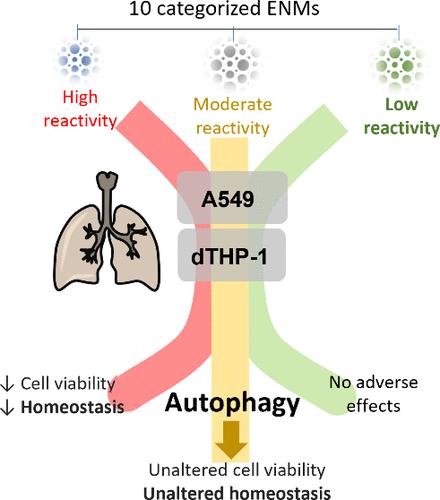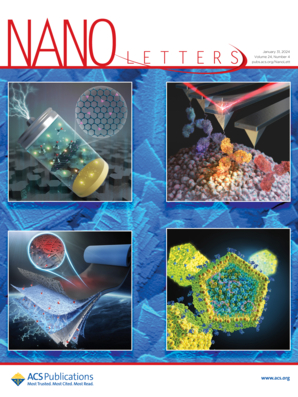Differentially Induced Autophagy by Engineered Nanomaterial Treatment Has an Impact on Cellular Homeostasis and Cytotoxicity
IF 9.6
1区 材料科学
Q1 CHEMISTRY, MULTIDISCIPLINARY
引用次数: 0
Abstract
Considering the increasing production of engineered nanomaterials (ENMs), new approach methodologies (NAMs) are essential for safe-by-design approaches and risk assessment. Our aim was to enhance screening strategies with a focus on reactivity-triggered toxicities. We applied in vitro tests to 10 selected benchmark ENMs in two cell models, lung epithelial A549 and differentiated THP-1 macrophage-like cells. Previously, we categorized ENMs based on surface reactivity. Here we elucidated their reactivity-triggered cytotoxicity and mode of action using the WST-1 assay (metabolic activity), LDH assay (cell membrane integrity), autophagosome detection, and proteomics. Nonreactive SiO2 NM-200 showed no significant impact on cell viability. Conversely, highly reactive CuO and ZnO (NM-110 and NM-111) disrupted cell homeostasis. Interestingly, moderately reactive TiO2 (NM-101 and NM-105) and CeO2 (NM-211 and NM-212), apparently without an adverse effect, induced autophagosome formation, evidencing autophagy as a defensive mechanism. Our improved in vitro testing strategy, combined with state-of-the-art reactivity information, screens ENMs for potential reactivity-triggered toxicity.

工程纳米材料处理不同程度诱导的自噬对细胞稳态和细胞毒性的影响
考虑到工程纳米材料(ENMs)的产量不断增加,新方法学(NAMs)对于安全设计方法和风险评估至关重要。我们的目标是加强筛选策略,重点关注反应引发的毒性。我们在两种细胞模型(肺上皮细胞 A549 和分化的 THP-1 巨噬细胞样细胞)中对 10 种选定的基准 ENM 进行了体外测试。在此之前,我们根据ENM的表面反应性对其进行了分类。在这里,我们使用 WST-1 检测法(代谢活性)、LDH 检测法(细胞膜完整性)、自噬体检测法和蛋白质组学阐明了反应性引发的细胞毒性和作用模式。非反应性二氧化硅 NM-200 对细胞活力没有明显影响。相反,高活性的氧化铜和氧化锌(NM-110 和 NM-111)破坏了细胞的稳态。有趣的是,中度反应性的 TiO2(NM-101 和 NM-105)和 CeO2(NM-211 和 NM-212)显然没有不良影响,却能诱导自噬体的形成,证明自噬是一种防御机制。我们改进的体外测试策略与最先进的反应信息相结合,可以筛选出具有潜在反应触发毒性的 ENM。
本文章由计算机程序翻译,如有差异,请以英文原文为准。
求助全文
约1分钟内获得全文
求助全文
来源期刊

Nano Letters
工程技术-材料科学:综合
CiteScore
16.80
自引率
2.80%
发文量
1182
审稿时长
1.4 months
期刊介绍:
Nano Letters serves as a dynamic platform for promptly disseminating original results in fundamental, applied, and emerging research across all facets of nanoscience and nanotechnology. A pivotal criterion for inclusion within Nano Letters is the convergence of at least two different areas or disciplines, ensuring a rich interdisciplinary scope. The journal is dedicated to fostering exploration in diverse areas, including:
- Experimental and theoretical findings on physical, chemical, and biological phenomena at the nanoscale
- Synthesis, characterization, and processing of organic, inorganic, polymer, and hybrid nanomaterials through physical, chemical, and biological methodologies
- Modeling and simulation of synthetic, assembly, and interaction processes
- Realization of integrated nanostructures and nano-engineered devices exhibiting advanced performance
- Applications of nanoscale materials in living and environmental systems
Nano Letters is committed to advancing and showcasing groundbreaking research that intersects various domains, fostering innovation and collaboration in the ever-evolving field of nanoscience and nanotechnology.
文献相关原料
| 公司名称 | 产品信息 | 采购帮参考价格 |
|---|
 求助内容:
求助内容: 应助结果提醒方式:
应助结果提醒方式:


